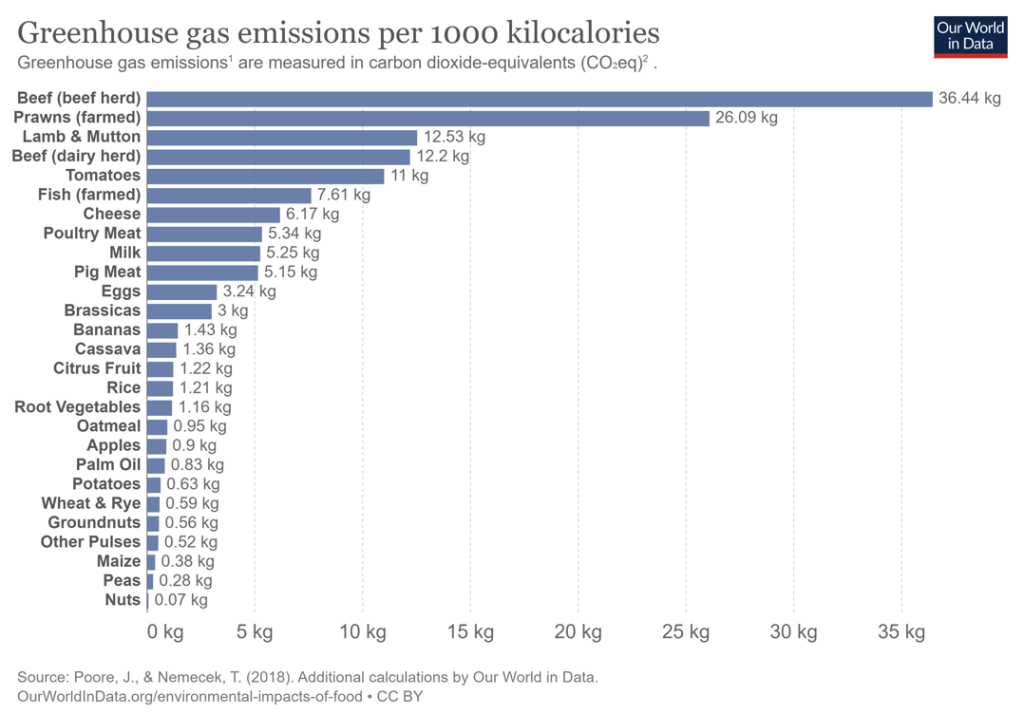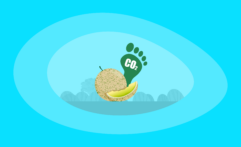What Is the Carbon Footprint of Lemons? A Life-Cycle Analysis
Impactful Ninja is reader-supported. When you buy through links on our site, we may earn an affiliate commission.
Learn more
Learn more
.
Hey fellow impactful ninja ? You may have noticed that Impactful Ninja is all about providing helpful information to make a positive impact on the world and society. And that we love to link back to where we found all the information for each of our posts. Most of these links are informational-based for you to check out their primary sources with one click. But some of these links are so-called "affiliate links" to products that we recommend. First and foremost, because we believe that they add value to you. For example, when we wrote a post about the environmental impact of long showers, we came across an EPA recommendation to use WaterSense showerheads. So we linked to where you can find them. Or, for many of our posts, we also link to our favorite books on that topic so that you can get a much more holistic overview than one single blog post could provide. And when there is an affiliate program for these products, we sign up for it. For example, as Amazon Associates, we earn from qualifying purchases. First, and most importantly, we still only recommend products that we believe add value for you. When you buy something through one of our affiliate links, we may earn a small commission - but at no additional costs to you. And when you buy something through a link that is not an affiliate link, we won’t receive any commission but we’ll still be happy to have helped you. When we find products that we believe add value to you and the seller has an affiliate program, we sign up for it. When you buy something through one of our affiliate links, we may earn a small commission (at no extra costs to you). And at this point in time, all money is reinvested in sharing the most helpful content with you. This includes all operating costs for running this site and the content creation itself. You may have noticed by the way Impactful Ninja is operated that money is not the driving factor behind it. It is a passion project of mine and I love to share helpful information with you to make a positive impact on the world and society. However, it's a project in that I invest a lot of time and also quite some money. Eventually, my dream is to one day turn this passion project into my full-time job and provide even more helpful information. But that's still a long time to go. Stay impactful,Affiliate Disclosure
Why do we add these product links?
What do these affiliate links mean for you?
What do these affiliate links mean for us?
What does this mean for me personally?
![]()
Lemons are a fantastic and diverse fruit, with over 40 different species existing globally. They are an excellent source of Vitamin C and taste amazing in drinks and baked goods. However, if you are a conscious eater, it’s important to understand the potential carbon footprint of the lemons you eat. There are lots of aspects to the lemon production process that could potentially be driving up your carbon footprint. So we had to ask: What is the carbon footprint of lemons?
The carbon footprint of lemons is 0.09kg (0.19lbs) CO2e per pound of lemons, which is fairly low compared to other fruits. The main contributing factors to their carbon footprint are the pesticides used in production, long transportation distances, and the lack of proper waste management.
In this article, we will be exploring all the aspects of the lemon production process, including growing, packing, transportation, and waste management, to examine exactly how lemons impact the planet through their carbon emissions. You will discover the complete impact that lemons have from start to finish. We will also offer you some important pointers on how you can offset or reduce your carbon footprint. So without further ado, let’s look into the carbon footprint of the lemon!
Here’s How We Assessed the Carbon Footprint of Lemons
The carbon footprint is one of the ways we measure the effects of our human-induced global climate change. It primarily focuses on the greenhouse gas (GHG) emissions associated with consumption, but also includes other emissions such as methane (CH4), nitrous oxide, and chlorofluorocarbons, and is generally expressed in carbon dioxide equivalents (CO2e).
“Carbon footprint: the amount of greenhouse gases and specifically carbon dioxide emitted by something (such as a person’s activities or a product’s manufacture and transport) during a given period”
Merriam Webster
Basically, it is the amount of carbon emitted by you as an individual or an organization providing you with goods and services – including lemons:
- This includes GHG emissions from producing the products that we use and foods that we eat (e.g., power plants, factories or farms, and landfills)
- GHG emissions from fuel that we burn directly or indirectly (e.g., logistics and transportation, cooling or heating facilities),
- as well as the GHG emissions attributed to how we consume these products and foods.
To understand the carbon footprint of lemons, we must assess its life-cycle and each stage’s sustainability. This life-cycle assessment (LCA) is a method to evaluate the environmental impacts of products and materials.
Here’s the Overall Carbon Footprint of Lemons
The overall carbon footprint for lemons is around 0.09kg (0.19lbs) CO2e per pound of lemons consumed in the US. This is mainly due to the transportation requirements to get them from to American grocery stores, the waste management of their peels, and some of the pesticide practices used. But despite these drawbacks, lemons are still a sustainable choice.
Lemons are a tart, delicious treat, but their lovely flavors come with a carbon footprint. There are plenty of places in their growth, transportation, and consumption processes that can have an impact on the earth. Of course, they are more carbon-conscious than the average fruit, but you should still know about all the possible impacts they could have.
| The carbon footprint of lemons | 0.09kg (0.19lbs) CO2e per pound of lemons |
So, let’s have a look at each stage of the LCA of lemons!
| The life-cycle stages of lemons | Each stage’s carbon footprint |
| Growing of lemons | Lemons have a moderate climate footprint when it comes to their growing stage. The main contributors to the lemon’s carbon footprint are excess irrigation and the use of pesticides. |
| Harvesting, processing, and packaging of lemons | Harvesting, processing, and packaging do not contribute very significantly to the carbon footprint of lemons. The biggest contribution is paper-based packaging. |
| Transporting of lemons | The carbon footprint of lemon transportation is relatively high, since most lemons consumed in the US are foreign-grown. Refrigerated cargo containers also contribute to the overall transportation carbon footprint of lemons. |
| End-of-life of lemons | Waste accounts for a significant amount of the carbon footprint of lemons. This is mainly due to most of the waste going into landfills, where they contribute to greenhouse gasses. |
These measurements represent the fundamental breakdown of how each step affects lemon production, but they are only part of the story. In the ensuing sections, we will go much more in-depth about the various ways in which lemons can impact the planet.
What Is the Carbon Footprint of Growing Lemons
Lemons have a moderate climate footprint when it comes to their growing stage. The main contributors to the lemon’s carbon footprint are excess irrigation and the use of pesticides.
When lemons are grown, there are a lot of things that can impact their carbon footprint. They are grown all over the world, from the Amalfi coast to India to Arizona. But what are the practices that actually work towards influencing their carbon footprint?
Which factors impact the carbon footprint of growing lemons?
- How do lemons grow: Lemons grow on trees, which is very good for their carbon footprint numbers because trees absorb and store carbon. Furthermore, Lemon trees have a higher carbon storage rate than other citrus trees and trees in general, which greatly reduces their carbon footprint.
- What is the growth duration of lemons: Lemon trees take about 3–5 years to mature to fruit-bearing age. Once this happens, a lemon will take about 9 months to transition from flower to fruit. Lemon trees also have excellent longevity, living anywhere from 50–100 years.
- What is the land usage of lemons: Depending on the planting practice, farms can hold around 300 lemon trees per hectare. This is significantly less than oranges, which tend to house about 400 trees per hectare. However, apples only fit 250 trees per hectare. Therefore, lemon trees take up more land than other citrus fruits, but are still better than many other fruits in general.
- What is the water usage of lemons: Mature lemon trees need about 60 inches (150cm) of water per year, but young trees need twice this amount. Lemons are often grown in places like Arizona, which only gets 12 inches of rain per year. So, they need a significant amount of irrigation. The annual rainfall of their growth region will dictate how much excess water they require.
- What is the pesticide and fertilizer usage of lemons: Unfortunately, lemons have a bad track record when it comes to pesticides. They are typically treated with imazalil and thiabendazole, the former of which is a known carcinogen and both of which are harmful to the body. Pesticide use also increases the carbon footprint of lemons at this stage.
Lemons have some good qualities and some bad ones when it comes to their carbon footprint. On the good side, we have their carbon-trapping abilities and relatively dense tree distribution. However, they require a lot of irrigation and the use of dangerous pesticides.
In short, the carbon footprint of growing lemons is moderate, but still comes with some risks. There is a lot of excess water needed to keep them hydrated and a lot of dangerous pesticides used to keep them safe.
What Is the Carbon Footprint of Harvesting, Processing, and Packaging Lemons
Harvesting, processing, and packaging do not contribute very significantly to the carbon footprint of lemons. The biggest contribution is paper-based packaging.
When lemons are ripe, they need to be harvested. This can be done a number of different ways, either by hand or by machine. They also need to be processed and packaged, which may require some carbon emissions. Let’s look at how this process works within the context of lemons!
Which factors impact the carbon footprint of harvesting, processing, and packaging lemons?
- How are lemons harvested: Lemons are generally harvested by hand. This means that there is generally no carbon required in the process of harvesting them.
- How are lemons processed: After they are picked, lemons are loaded into large vats that hold up to 900 pounds of lemons. The lemons are evaluated based on their quality and the ones that aren’t good enough to sell in stores (around 20%) are used instead for juice or extract. This process is fairly low in its carbon impact.
- How are lemons packaged: Once lemons have been processed, they are then typically sorted into boxes made of cardboard, which have a carbon footprint due to the deforestation required to make them.
Besides the potential packaging consequences, there is relatively little to worry about when it comes to the carbon footprint of harvesting, processing, and packaging lemons. Since there is relatively little electricity used in the actual harvesting process, they can remain very carbon neutral.
The carbon footprint of the packaging process of lemons is fairly minimal. However, there are a few risks, such as excess packaging that contributes to deforestation.
What Is the Carbon Footprint of Transporting Lemons
The carbon footprint of lemon transportation is relatively high, since most lemons consumed in the US are foreign-grown. Refrigerated cargo containers also contribute to the overall transportation carbon footprint of lemons.
For lemons to make their way to the grocery store, they need to be transported from the farm. There are several methods with which fruits can be transported. However, they usually travel in refrigerated trucks, which can have a higher carbon footprint. Let’s see how lemons are specifically impacting the environment through their transportation.
Which factors impact the carbon footprint of transporting lemons?
- Where are lemons grown: Mexico is the world’s leading producer of lemons. However, the majority of lemons consumed in the US are from Chile and Argentina. There is also a significant amount from New Zealand and Australia. Within the US, they are mainly grown in Arizona and California. This means that your lemons could have wildly different carbon footprints, depending on where they are being grown.
- How are lemons transported: Lemons are refrigerated cargo, meaning that they require electricity to cool them at every level of the transportation process. This drives up their carbon footprint due to the extra energy used. Typically, they will be transported in cargo boxes on ships.
Since the majority of US-consumed lemons are from South America, there is a significant carbon footprint involved. However, domestically-grown lemons will have much smaller footprints. So, pay attention to the labels to evaluate your personal footprint.
In short, most lemons consumed in the US have a fairly high carbon footprint, owing to the long transportation times and the electricity required to cool the trucks or cargo containers.
What Is the Carbon Footprint of the End-of-Life of Lemons
Waste accounts for a significant amount of the carbon footprint of lemons. This is mainly due to most of the waste going into landfills, where they contribute to greenhouse gasses.
After the fun part—eating the lemons—you also have to figure out what to do with the waste. Lemons have a significant amount of waste, due to the peels, and so there will be a carbon footprint as a result. Here, we will look at how parts of a lemon are typically disposed of and how that impacts the planet.
Which factors impact the carbon footprint of the end-of-life of lemons?
- How are lemons disposed of: Lemon peels are biodegradable. However, they often end up in landfills, since roughly only 4% of food waste is composed. Unfortunately, food waste in landfills releases methane gas, which is a harmful greenhouse gas that can contribute to climate change. Thus, lemons can actually have a significant climate impact simply through the disposal of their peels.
- How is the packaging of lemons disposed of: Much of the packaging of lemons is done with cardboard boxes which are used to transport lemons to the grocery store. These can be recycled, and since cardboard has the highest recycling rate of any recyclable material at 89%, the packaging is unlikely to end up in landfills, meaning that packaging does not contribute significantly to the overall carbon footprint of the lemon.
The waste management of lemons can be significantly problematic when it comes to their carbon footprint, despite all the products being recyclable or compostable. In practice, most of the waste from lemons goes into landfills and so can drive up the carbon footprint.
In short, waste is a significant contributor to the carbon footprint of lemons. The main reason for this is the bad waste disposal practices that cause compostable materials to end up in landfills.
How Does the Carbon Footprint of Lemons Compare to Other Types of Food
Lemons rank extremely low compared to other foods in terms of their overall carbon footprint. If you are looking for one of the most sustainable foods to eat, then look no further than lemons.
Comparing lemons to other foods can help you get a sense of where their carbon footprint stands in the grand scheme of things. If they have a relatively higher or lower carbon footprint than some other foods, then you will be able to make easier decisions about what to buy. In this next section of the article, we will be showing you how lemons compare with many other foods.
How Does the Carbon Footprint of Lemons Compare to Other Types of Fruits
Fruit in particular can be useful to compare to lemons, given that they might have similar carbon footprints to one another. Generally, fruits will have a smaller carbon footprint than meat or dairy, but it’s still important to know where they rank, as there is a lot of variation.
| Fruits | Carbon Footprint per lbs | Calories per lbs | Carbon Footprint per Calories |
| Avocados | 0.85 kg (1.9 lb) of CO2e per pound of avocados | 725 calories per pound | 1.17kg (2.57lb) of CO2e per 1,000 calories of avocados |
| Grapes | 0.64 kg (1.42 lbs) of CO2e per pound of grapes | 300 calories per pound | 2.13kg (4.7lb) of CO2e per 1,000 calories of grapes |
| Cantaloupes | 0.58kg (1.3lb) of CO2e per pound of cantaloupe | 154 calories per pound | 3.77kg (8.31lb) of CO2e per 1,000 calories of cantaloupes |
| Kiwis | 0.56kg (1.24lb) of CO2e per pound of kiwis | 277 calories per pound | 2.02kg (4.45lb) of CO2e per 1,000 calories of kiwis |
| Blueberries | 0.45kg (1lb) of CO2e per pound of blueberries | 256 calories per pound | 1.75kg (3.86lb) of CO2e per 1,000 calories of blueberries |
| Plums | 0.4 kg (0.88 lb) CO2e per pound of plums | 209 calories per pound | 1.91kg (4.21lb) of CO2e per 1,000 calories of plums |
| Strawberries | 0.39kg (0.88lb) of CO2e per pound of strawberries | 145 calories per pound | 2.69kg (5.93lb) of CO2e per 1,000 calories of strawberries |
| Pomegranates | 0.39kg (0.87lb) of CO2e per pound of pomegranates | 375 calories per pound | 1.04kg (2.29lb) of CO2e per pound of pomegranates |
| Figs | 0.3kg (0.68lb) of CO2e per pound of figs | 333 calories per pound | 0.9kg (1.98lb) of CO2e per 1,000 calories of figs |
| Papayas | 0.3kg (0.67lb) of CO2e per pound of papayas | 195 calories per pound | 1.54kg (3.4lb) of CO2e per 1,000 calories of papayas |
| Oranges | 0.3kg (0.66 lb) CO2e per pound of oranges | 213 calories per pound | 1.41kg (3.11lb) of CO2e per 1,000 calories of oranges |
| Dates | 0.27kg (0.6lb) of CO2e per pound of dates | 1,300 calories per pound | 0.21kg (0.46lb) of CO2e per 1,000 calories of dates |
| Apples | 0.24 kg (0.53 lb) of CO2e per pound of apples | 236 calories per pound | 1.02kg (2.25lb) of CO2e per 1,000 calories of apples |
| Pears | 0.23kg (0.52 lb) of CO2e per pound of pears | 259 calories per pound | 0.89kg (1.96lb) of CO2e per 1,000 calories of pears |
| Bananas | 0.21 kg (0.48 lb) of CO2e per pound of banana | 404 calories per pound | 0.52kg (1.15lb) of CO2e per 1,000 calories of bananas |
| Mangoes | 0.21 kg (0.46 lb) CO2e per pound of mangoes | 272 calories per pound | 0.77lb (1.7lb) of CO2e per 1,000 calories of mangoes |
| Cherries | 0.19kg (0.41 lb) of CO2e per pound of cherries | 227 calories per pound | 0.84kg (1.85lb) of CO2e per 1,000 calories of cherries |
| Limes | 0.18kg (0.39lb) of CO2e per pound of limes | 136 calories per pound | 1.32kg (2.91lb) of CO2e per 1,000 calories of limes |
| Peaches | 0.17kg (0.38lb) CO2e per pound of peaches | 176 calories per pound | 0.97kg (2.14lb) of CO2e per 1,000 calories of peaches |
| Apricots | 0.16kg (0.36lb) of CO2e per pound of apricots | 218 calories per pound | 0.73kg (1.61lb) of CO2e per 1,000 calories of apricots |
| Raspberries | 0.15kg (0.33lb) of CO2e per pound of raspberries | 240 calories per pound | 0.63kg (1.39lb) of CO2e per 1,000 calories of raspberries |
| Pineapples | 0.09 kg (0.20 lb) of CO2e per pound of pineapple | 227 calories per pound | 0.4kg (0.88lb) of CO2e per 1,000 calories of pineapples |
| Lemons | 0.09kg (0.19lb) CO2e per pound of lemons | 132 calories per pound | 0.68kg (1.5lb) of CO2e per 1,000 calories of lemons |
| Grapefruit | 0.08kg (0.18lb) of CO2e per pound of grapefruit | 191 calories per pound | 0.42kg (0.93lb) of CO2e per 1,000 calories of grapefruits |
| Blackberries | 0.07kg (0.15lb) of CO2e per pound of blackberries | 195 calories per pound | 0.36kg (0.79lb) of CO2e per 1,000 calories of blackberries |
| Clementines | 0.06 kg (0.13 lb) CO2e per pound of clementines | 213 calories per pound | 0.28kg (0.62kg) of CO2e per 1,000 calories of clementines |
| Watermelons | 0.05kg (0.11 lb) of CO2e per pound of watermelon | 136 calories per pound | 0.37kg (0.82lb) of CO2e per 1,000 calories of watermelons |
Compared to all the other fruits on the list, lemons rank the lowest, tied with pineapples. This contributes to lemons being some of the most sustainable fruits you can eat. They are almost 1/10th of the carbon footprint of the highest fruit on the list, avocados!
How Does the Carbon Footprint of Lemons Compare to Other Types of Food in General
Lemons may rank very low among other fruits and vegetables, but how do they rank in general compared to other foods? In this section, we will explore how lemons rank in the grander scheme of foods.
When it comes to greenhouse gas emissions (GHG), foods are often compared in terms of emissions per 1,000 kilocalories (as opposed to their weight in lbs or kg).

In relation to other foods on the list, lemons rank around in the middle of the chart, with the other citrus fruits, meaning that they are somewhat sustainable, but there are quite a few other foods that you can eat to reduce your carbon footprint even more.
Unfortunately, although lemons are relatively low in carbon emissions compared to other fruits, they rank a little higher when kilocalories are taken into account:
- This is partially because lemons have a lower calorie count per unit than some other fruits, with only about 20 calories per lemon, or 60 calories per pound of lemons,
- compared to the average 95 calories in an apple, or 300 calories per pound of apples, for example.
- This drives up their carbon footprint per kilocalorie, causing them to be in the middle range on this chart, when they are in the lower range in terms of total carbon footprint.
Despite this, lemons are still one of the most sustainable fruits you can eat, especially when considered from a pure carbon footprint per pound angle.
How Can You Reduce and Offset Your Personal Carbon Footprint
You can do a number of things to both offset and reduce the carbon footprint of your lemon consumption. Reducing involves consuming less or mitigating some of the more harmful consumption habits. Offsetting refers to the reduction or removal of greenhouse gasses to compensate for emissions made elsewhere.
Even though lemons are a relatively sustainable fruit, you are still probably wondering how you can make them even more sustainable, or at least compensate elsewhere for that consumption. The good news is there are a lot of ways to do both. Here, we will look at how you can both reduce your consumption and also offset your emissions so that you can eat lemons with better peace of mind!
How Can You Reduce Your Carbon Footprint When Shopping for Lemons
When it comes to making a positive impact, reducing how much you consume is key. Of course, you could always eat fewer lemons, but there are also different ways in which you can consume them that will actually reduce your footprint. In other words, if you are smart about your consumption, you can actually consume just as many lemons with a far smaller footprint! Here, we will look at some of the best ways to bring your lemon carbon footprint down.
- Grow your own: To have the most sustainable lemons possible, you can grow them yourself. The biggest area you will be reducing is transportation, since you will no longer require fuel-guzzling refrigerated containers. Transportation is one of the biggest contributors to the lemon’s carbon footprint,so you will be practicing much more sustainable lemon consumption. Plus, you can opt not to use pesticides, which can make your lemons even healthier! One tree yields about 80–100 kg (175–200 lbs) of lemons a year, which is about a lemon a day, more than enough for most people. Grow indoors or outdoors, depending on your climate.
- Purchase domestic lemons: If you don’t have the space to grow your own lemons, you can do the next best thing and purchase lemons grown in the US or, better yet, in your local area. This will greatly reduce transportation times and thus the emissions used in that stage.
- Properly dispose of waste: One of the biggest contributors to lemons’ carbon footprint is the improper disposal of waste. So, by making sure you compost all lemon peels and recycle any cardboard packaging, you can reduce the impact of the end-of-life stage of the lemon’s life cycle.
- Use the whole lemon: Lemon peels are actually very useful for a variety of things. For one, zest is a common ingredient in recipes like lemon cakes and salad dressings. But it can also be used in other things like cleaning products and soaps. Challenge yourself to come up with unique uses for the lemon peels instead of throwing them away!
All these methods are excellent ways to bring down your carbon footprint when eating lemons. However, actually reaching zero carbon can be near impossible. Thus, to reach net zero (or even become net positive), you could offset your carbon emissions!
How Can You Offset Your Personal Carbon Footprint
Carbon offsets are reductions in carbon emissions that are used to compensate for carbon emissions occurring elsewhere – for example for the carbon emissions that are associated with lemons. They are measured in tons of CO2 equivalents and are bought and sold through international brokers, online retailers, and trading platforms on what is known as the global carbon offset market.
“Carbon Offset: a way for a company or person to reduce the level of carbon dioxide for which they are responsible by paying money to a company that works to reduce the total amount produced in the world, for example by planting trees”
Oxford Dictionary
In terms of lemons – and indeed all food types – there will always be a carbon footprint, because of the resources it takes to get your food from farms to the place where you’ll eventually eat them. And while there are ways to reduce your carbon footprint when shopping for lemons, carbon offsets would be a way to reduce your CO2e emissions all the way down to net zero (or even to become climate positive).
However, when you purchase carbon offsets, it’s important that they actually make a difference in offsetting (aka reducing) total carbon emissions. To achieve that, the following are key criteria:
- Carbon offset projects have to be effective (different projects have different effectiveness rates)
- Carbon offset projects have to be additional
- Carbon offset projects have to be permanent
- The claims from carbon offset projects have to be verifiable
To find the best carbon offsets for you personally, check out our full guide on the best carbon offsets for individuals, where you’ll also learn more about how these carbon offset projects work, what their respective offsetting costs are, and what your best way would be to offset your own carbon emissions.
Final Thoughts
The results are in: If you are a frequent lemon-eater, then you are consuming one of the most sustainable fruits out there. Yes, there are some aspects of their production and general life cycle that might cause more emissions. The transportation stage of the process tends to emit a lot of carbon, the pesticide use is fairly high, and most people don’t dispose of the waste properly. But despite all these things, lemons still have a very low carbon footprint, especially when compared to many other fruits. So next time you get a hankering for a cool glass of lemonade on a hot day, do so with the knowledge that your impact is relatively small!
Stay impactful,

Sources
- Feast and Field: The Lowly Lemon? No Way: The Fruit’s Most Fascinating Facts
- Healthline: Lemons 101: Nutrition Facts and Health Benefits)
- Alimpo: Carbon Footprint of the Lemon Sector in Spain
- Britannica: Carbon footprint
- Science Direct: Life-cycle assessment (LCA)
- MIT SMR: Strategic Sustainability Uses of Life-Cycle Analysis
- Pennington: How to Grow and Care for an Indoor Lemon Tree.
- USDA: Trees are Climate Change, Climate Storage Heroes.
- Green Upside: When Does a Lemon Tree Bear Fruit?
- Home Guides: How Does a Lemon Tree Grow?
- Wikifarmer: Orange Tree Harvest and Yields
- Ontario: Apple Rootstocks.
- Pepper Shome and Garden: How Much Water Do Lemon Trees Need?
- AZ Climate: Climate of Arizona.
- EWG: Tests Find Hormone-Disrupting Fungicide in Most Citrus Fruits
- Cost Study Files: Lemons
- Ehow: In What Countries Do Lemons Grow?
- The Packer: Lemon Consumption Increases Slightly.
- TIS GOV: Lemons – Transporting Information Service.
- EPA: Reducing the Impact of Wasted Food
- BC GOV: Food and Organic Waste.
- Also Known As: 12 Interesting Facts About Garbage and Waste Disposal.
- Impactful Ninja: What is the Carbon Footprint of Avocados
- Impactful Ninja: What is the Carbon Footprint of Oranges
- Co2 Everything: Berries
- Helabel: Kiwis.
- Co2 Everything: Apple
- Helabel: Strawberries.
- Co2 Everything: Banana
- Helabel: Plum
- Helabel: Peach
- Researchgate: Average Carbon Footprint and Contribution of Fresh Pineapple Production
- Our World in Data: Greenhouse Gas Emissions per 1000 kilocalories
- Nutritionix: Calories in Apple
- Planted Cravings: Moist Lemon Cake Recipe
- Food and Wine: Honey-Lemon Dressing
- Wonky Wonderful: Nontoxic Lemon Vinegar Cleaner
- Hearts Content Farmhouse: Lemon Soap Recipe
- Impactful Ninja: Best Carbon Offsets for Individuals




